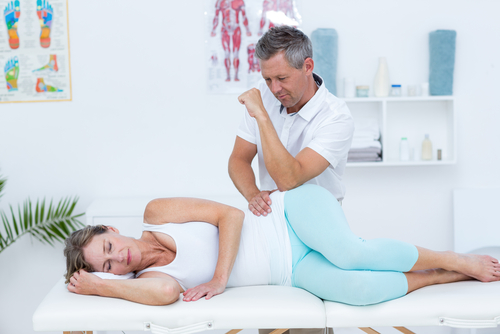We often only recognize pain when we’re in motion, because we’re likely applying stress to the affected muscles and joints. But sometimes, we don’t recognize pain until we’re at rest. When it comes to hip pain, it’s possible that you’re only experiencing the ache when you’re sitting at your work desk or eating dinner at your dining room table.
Hip pain that occurs when sitting can be frustrating, because it’s impossible to stay on your feet all day. Since the action of sitting can’t be avoided, acknowledging the hip pain shouldn’t be avoided either. By determining the likely cause of pain in your hip when you’re sitting, you can take the right steps to alleviate it with safe and effective treatments.
We’ll dive into the possible explanations for hip pain when sitting before exploring potential treatment options that may help, including physical therapy.
7 possible causes for hip pain when sitting
Not all hip pain when sitting is a call for concern. For example, you might have bumped into something. There are also many possible reasons for the pain beyond a condition or injury. There are habits and unconscious behaviors that can contribute to it. But if you feel hip pain nearly every time you sit down, possibly worsening with each instance, then you should book an appointment with your doctor.
It’s important that you talk to your doctor about recurring hip pain when sitting and any other related symptoms, such as stiffness in the hip joint. If they believe that a medical condition or injury is the cause, they may order tests, such as an X-ray, for a proper diagnosis.
Here are seven possible causes for hip pain that occurs when sitting:
- Poor posture — If your shoulders are slouched when you sit or your neck is overextended, it can put excessive strain on your hip muscles and ligaments, leading to pain. The joints can also become compressed, as slouching causes the hip to internally rotate. Poor posture also goes hand in hand with unsupportive sitting positions when it comes to hip pain, such as crossing your legs or leaning to one side of your chair.
- Unstable surface — When you’re sitting on any sort of surface, whether it be a chair, couch or bench, it’s important that your body weight is evenly distributed between both hips. If one side is favored due to a broken leg chair, or it’s placed on uneven ground, you could be putting excessive stress on the hip joint and muscles, leading to pain.
- Sciatica — Your sciatic nerve is the longest nerve in your body, and it starts in your lower back and runs down the back of each leg. When you have pain that travels down the nerve, it’s known as sciatica. The pain is often felt through the hip, buttock and one leg, and it can flare up when you sit. The hip pain may also occur alongside numbness or weakness in the area.
- Pinched nerve — Often referred to as a compressed nerve or radiculopathy, a pinched nerve means that something has applied pressure to it, such as a bone spur, tendon or piece of cartilage. It’s possible to pinch a nerve in your hip if you sit for an extended period of time. It can cause radiating pain along the nerve that’s exacerbated with further sedentary positions. It can also cause numbness and tingling.
- Arthritis — It’s possible that the cartilage surrounding your hip joint can wear out with time, leading to arthritis in the hip. It can cause pain and stiffness when you sit due to bending the hip joints, with the tight position causing them to swell or rub together. There are many types of arthritis that can develop in the hip, but osteoarthritis is the most common.
- Bursitis — There are many bursae located in the hip, which are fluid-filled sacs that work as cushions to protect the tendons and muscles from rubbing against the bone. A bursa can become inflamed due to overuse or repetitive movement, causing hip pain that may worsen if you’ve been sitting for an extended period of time.
- Labral tear — There’s a ring of cartilage that protects your hip socket, known as the labrum. Repetitive hip movements can cause the labrum to tear, leading to hip pain that can worsen when sitting. A labral tear can also result in other symptoms, including a joint locking sensation, stiffness and muscle weakness.
7 treatments for hip pain that occurs when sitting
Now that we’ve discussed the possible causes of hip pain that flares up when sitting, it’s time to figure out how to alleviate it. There are a variety of treatment options that are worth exploring. Some of them can be completed at home, while others may require the assistance of a health care professional, such as your general physician or a physical therapist.
Here are seven treatments worth testing out to reduce hip pain that occurs when sitting:
- Hot and cold therapy — A tried-and-true method of temporary pain relief is switching between applying cold packs and warm compresses. Applying an ice pack to your hip for 20-minute increments can numb the area, reduce inflammation and slow down blood flow. Alternate the ice pack with a warm compress to relax the muscles and increase blood circulation.
- Take breaks from sitting — Many causes of hip pain from sitting are started by, or exacerbated, by sitting for long periods of time. If you’re sitting for extended periods of time, such as working at a desk job, be sure to take intermittent breaks where you’re standing and walking around to reduce excessive stress on the joints.
- Medication — If you’re looking for temporary pain relief for your hip, be sure to ask your doctor about taking over-the-counter pain medication, such as acetaminophen and ibuprofen.
- Postural adjustment — Your posture is often unconscious. You might not even recognize that you’re slouching when you’re sitting until you feel hip pain. A physical therapist can help you make gradual postural adjustments to reduce the strain on your hip joint and muscles.
- Supportive cushion — You can improve your posture by using the right supportive cushion or pillow. Since you can’t avoid sitting, especially if you work at a desk, it can be helpful to make your chair as comfortable and supportive as possible. A cushion can not only alleviate the pain by reducing stress on the joint, but it can also ensure that your weight is evenly distributed across your hips.
- Targeted stretches — One of the most effective ways to reduce your hip pain is through stretches. A physical therapist can guide you through safe exercises to increase your joint’s mobility by boosting the flexibility of the surrounding muscles. Common stretches for hip pain include hamstring stretches and hip flexor stretches.
- Active Release Techniques® — ART involves a physical therapist using their hands to break up tight scar tissue that’s causing your hip pain while helping to restore the hip’s range of motion. It also helps to decrease inflammation by stimulating the lymphatic system.
SOL Physical Therapy can help you sit comfortably with less hip pain
It can be frustrating to feel an ache in your hip every time you sit down, as that’s when you expect your body to relax. The good news is that at SOL, we can help you alleviate your hip pain while improving the overall quality of the area to reduce the risk of future pain or injury. Treatments like ART, targeted stretches and postural adjustment will help you sit more comfortably with less hip pain.
Call us or request an appointment today to reduce hip pain when sitting.


